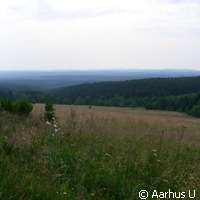Modern ecosystems feel ancient climate change effect

Earth's animals migrate to ensure their survival in suitable conditions. This is especially true when climate cycles switch between warm and cool periods. Now researchers in Denmark and the United Kingdom shed new light on how quickly species have had to migrate in the past in order to keep pace with the changing climate. Presented in the journal Science, the findings show how small-ranged species - which account for most of the planets biodiversity - have found a niche in areas where migration has not been intense.
Researchers from Aarhus University in Denmark and the Universities of Cambridge, East Anglia and Exeter in the United Kingdom postulate that climate change triggered by human activities will significantly raise the required migration rates in many of these locations, threatening the planet's one-of-a-kind fauna.
According to the researchers, the Last Glacial Maximum - the period in the Earth's climate history when ice sheets were at their maximum extension (between 26,500 and 19,500 years ago) - was significantly cooler, forcing many species to move around much more often than today's animals do. They point out that northern European species are for the most part relatively recent arrivals from their refuges in southern Europe.
Working together with computer scientists at Aarhus' Center for Massive Data Algorithmics (MADALGO), ecologists at the Danish and British universities investigated the speed at which species moved around the world, and how these species migrated to keep up with this huge historical climate change. The work helped clarify whether differences exist in modern communities between areas with local and high required rates of migration.
The team determined the required migration rates by measuring how quickly climate conditions have moved over the planet's surface. The rate of temperature change through time as well as on local topography influences the velocity. For instance, the researchers found that on steep topography, travelling over short distances yields a large difference in temperature, which in turn triggers tiny climate-change velocities.
Failure of a species to migrate quickly in order to keep up with the velocity of climate change could lead to the decline of its range, and in turn, the extinction of the species. The probability of this happening is strong when climate-change velocity is high relative to the species' dispersal abilities.
The team mapped patterns of small-ranged species diversity for all terrestrial amphibians, mammals and birds in order to test this theory. They found that high concentrations of small-ranged species emerged where velocities were low (e.g. the South American Andes) while small-ranged species were rare where velocities were high (e.g. northern Europe).
Velocity affected weak dispersers (i.e. amphibians) the most, while the strongest dispersers (i.e. birds) were affected the least. As for mammals, bats demonstrated patterns similar to birds, while non-flying mammals had similar patterns to amphibians.
The research therefore uncovered a link between the required migration velocity, the capacity of a species to disperse in response, and the probability that climate change will trigger the extinction of a species.
According to the scientists, their results provide evidence that former regional climate shifts interact with local topography and species dispersal abilities, with long-term, significant consequences for the global distribution of biodiversity.
Climate change triggered by human activities is increasing climate-change velocities, they say. There are a number of regions around the globe, such as the Amazon Basin as well as locations in Africa, where velocities have traditionally been somewhat low but will likely increase by 2080. Mostly small-ranged species are found in these areas, and they will probably be at particular risk as velocities increase between now and the next 70 or so years.
More information: Sandel, B. et al. (2011) 'The influence of late quaternary climate-change velocity on species endemism'. Science, published 6 October. DOI: 10.1126/science.1210173
Provided by Aarhus University















